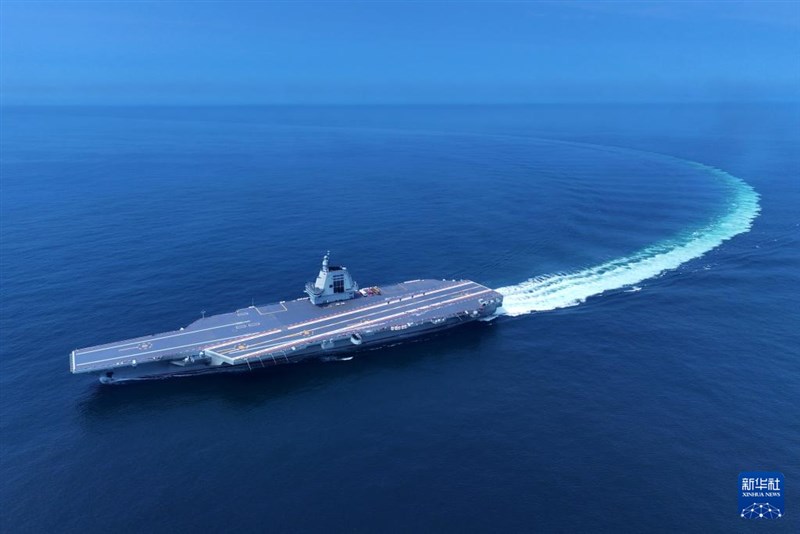China's 3rd carrier highlights its potential leverage over U.S.: Expert

Taipei, Sept. 13 (CNA) China's third aircraft carrier, the Fujian, which recently sailed through the Taiwan Strait, signals the country's expanding naval power that Beijing could leverage against the United States, a defense expert said on Friday.
Launched in 2022, the Fujian is China's third aircraft carrier, following the Liaoning and Shandong, with a full-load displacement of over 80,000 tons.
China's state-run Xinhua News Agency reported Friday that the Fujian had passed through the Taiwan Strait to "carry out scientific research tests and training missions" in the South China Sea.
Citing Senior Captain Leng Guowei (冷國偉), a spokesperson for the People's Liberation Army Navy, Xinhua said the tests and training were "not aimed at any specific target," but were regular arrangements in the carrier's construction process.
However, the sea trials in the South China Sea carried political implications, said Su Tzu-yun (蘇紫雲), a division director at the Institute for National Defense and Security Research (INDSR).
They demonstrate China's growing strength with three aircraft carriers, which Beijing could use as leverage against the United States ahead of a potential meeting between Chinese President Xi Jinping (習近平) and U.S. President Donald Trump.
The Fujian had already been tested in the calmer East and Yellow Seas and recently transited through the Taiwan Strait to the South China Sea. It will likely be used to assess performance in deeper, more challenging waters, Su explained.
● Taiwan military tracks Chinese carrier's passage through Taiwan Strait
Chieh Chung (揭仲), an adjunct researcher at the INDSR, said China is likely to hold a commissioning ceremony for the Fujian on Oct. 1, but after that, the ship would still need to conduct training for its carrier-based aircraft units.
This means it can carry more aircraft on deck and, using an electromagnetic catapult system, launch one fighter jet per minute, Su said.
Chieh explained that once the Fujian achieves full combat capability, giving China three aircraft carrier strike groups, it would theoretically allow one carrier to undergo maintenance in port, one to lead a strike group training in the South China Sea, while the other patrols the western Pacific east of Taiwan.
This new posture could have significant implications for Taiwan's military defense operations, he said, noting that Taiwan's military would no longer be able to intercept Chinese carrier strike groups in strategic waterways before they enter the western Pacific.
Also, Taiwan's Navy and Air Force units stationed in the eastern parts of the country would be directly exposed to the long-range strike capabilities of Chinese carrier strike groups, posing a serious challenge to its military forces, Chieh added.
If China was to take military action against Taiwan, its aircraft carriers could be used to enforce a long-range blockade, conducting denial operations in the Pacific between Guam and Taiwan, Su said.
Under this scenario, Taiwan would need to rely not only on anti-ship missiles as a basic countermeasure but also on submarines to counter the Chinese carrier groups, he said, highlighting the continued importance of developing domestically built submarines.
- Society
China military drills to disrupt international flights to, from Taiwan
12/29/2025 09:52 PM - Society
Taipei to deploy 1,300 police officers for New Year's Eve event
12/29/2025 09:33 PM - Business
Taiwan's economy close to overheating: Economic indicator index
12/29/2025 09:25 PM - Society
Mercury to plunge on New Year's Day with arrival of cold air mass
12/29/2025 08:57 PM - Cross-Strait
PLA drill areas within Taiwan's territorial waters: Taiwan military
12/29/2025 07:56 PM